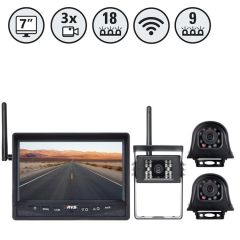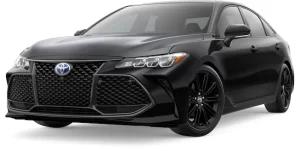The United States National Highway Traffic Safety Administration, often referred to as the NHTSA, introduced a law in May 2018 with regards to the addition of backup cameras in new vehicles. However, even before the law was enforced, the adoption of aftermarket backup cameras was a staple in different parts of the country. In fact, around 75 percent of all the vehicles in the United States were already fitted with some or the other type of backup cam.

In this article, we will discuss the origins of the backup camera, why backup cameras are important, why wireless ones are better than wired ones, and how to choose the best wireless backup camera or 360 degree vehicle cameras for your fleet.
Do you know the history of backup cameras for vehicles?
Here is a fun fact:
The first auto company to introduce a backup camera was General Motors. In its 1956 Buick Centurion, which was a concept car, the company installed a bulky camera that served as a reversing assistant to the driver. Conceptualized by Chuck Jordan, this design featured a TV camera that transmitted the captured footage to a screen on the vehicle’s dashboard.
Although the concept came into existence back in 1956, it wasn’t until 1991 that standard cars started seeing the addition of backup cams. The first car to feature a backup camera as a standard accessory was the Toyota Soarer in Japan.
What is the logic behind image flipping in a backup camera?
Contrary to most other cameras out there, a backup camera uses a unique technique to relay images. Vehicle backup cams flip the captured footage horizontally while relaying it to the driver. The reason behind this is that because the driver and the camera are facing opposite directions, the output that the driver sees would be wrong in terms of what is actually to his left and right if the image is not flipped. Flipping the footage ensures that what the driver sees is a mirror image, thus giving him the correct perspective of what is behind the vehicle.
Why are backup cameras so important in certain vehicles?
While backup cameras should be used in every vehicle, some vehicles need them more than certain others. Let us consider industrial vehicles, off-roading beasts, large SUVs, trucks, commercial vans, RVs, sporty cars with low ground clearance, and other such vehicles that have a non-traditional design for the sake of this discussion. If you have driven one of these, you will know that backing up is far more difficult than a regular hatchback or sedan, given the odd angles and the driver’s line of sight (which doesn’t always align with the ORVMs and conventional rear view mirror). That is where backup cameras become a necessity because they provide you with a clear view of what is directly behind your vehicle, especially when navigating tricky parking spots or uneven terrain.
Why are wireless backup cameras better than their wired counterparts?
With advancements in auto technology, we have seen a variety of vehicle accessories get cool upgrades. Backup cameras, too, have seen rapid evolution over the last three decades, with wireless backup cams becoming the norm in 2023.
Today, wireless backup cameras are a staple in all kinds of vehicles, including RVs, pickup trucks, commercial vans, cargo carriers, trucks, trailers, buses, emergency vehicles, industrial vehicles, and cars. They are obviously important because of the immense assistance they provide in terms of maneuverability and safety, so there is no reason why you should not consider investing in a high-quality camera.
Now, the debate comes down to which type of backup camera is better – a wired one or a wireless one? Well, while you get truckloads of options and features in both wired and wireless cameras, let us focus on the wireless ones today. Wireless backup cameras offer unparalleled ease in terms of installation. For starters, you do not need to alter or modify the vehicle in any way while installing a wireless backup camera. No messy cables, no wiring, no drilling, and no holes! This not only saves time and effort, but also allows you to keep your vehicle’s original form intact.
How to select the best wireless backup camera for your needs
Once you have made up your mind about investing in a wireless cam, it is important to consider the following things before you make a buying decision.
1. Understand your vehicle
The first consideration while selecting a wireless camera for your vehicle is the vehicle type itself. For example, if you have a truck trailer or a pickup truck, it would be wise to invest in a wireless cam with night vision capabilities. The reason for this is that if you move around a lot in low-light situations or badly lit conditions, the night vision enabled cameras can help you drive, reverse, and park more confidently. On the other hand, if you have a commercial cargo van, you can look at options that provide a high degree of weather resistance. For relatively larger vehicles, it is crucial that you opt for wireless backup cams that offer a wide field of view so that you get the complete picture and don’t miss out on any blind spots.
2. Assess your drivers’ needs
Ask your drivers what their biggest challenges are and shortlist a couple of options accordingly. This is important because you might find a certain backup cam appealing but it might not necessarily align with your fleet drivers’ unique needs or address their challenges. A particular feature that you might overlook could actually be the primary thing they expect in their vehicle’s camera. So, take a quick survey to understand their needs and demands before making a hasty buying decision.
3. Resolution and gridlines
While small vehicles like sedans, hatchbacks, SUVs, and pickup trucks can do with a mid-level camera in terms of the resolution, the same might not apply to relatively bigger vehicles. Consider investing in hi-res cameras for industrial vehicles, buses, trucks, and RVs so that you get crystal clear footage along with dynamic guidelines or grids that can help navigate tricky parking spots (especially while backing up).
4. Stable connection
When it comes to wireless backup cameras for trucks and vans, having strong and reliable connectivity is a must, especially for vehicles that tend to traverse through remote areas and travel to faraway destinations on a regular basis.
5. 360 degree coverage
In order to get a comprehensive view of all sides of the vehicle’s surroundings and negate blind spots, an advanced 360 degree wireless backup cam is the most ideal choice irrespective of the type of vehicle you have. Modern 360 vehicle cameras come with a host of amazing features, including infrared technology, night vision capabilities, low sensitivity to light, parking assistance, motion detection, object sensors, and superior wireless connectivity.
At Rear View Safety, we offer a massive variety of vehicle safety products, including wireless backup cameras for buses, trucks, trailers, RVs, cars, industrial vehicles, and more. Discover our entire catalog and choose the best wireless backup cameras for your fleet.


